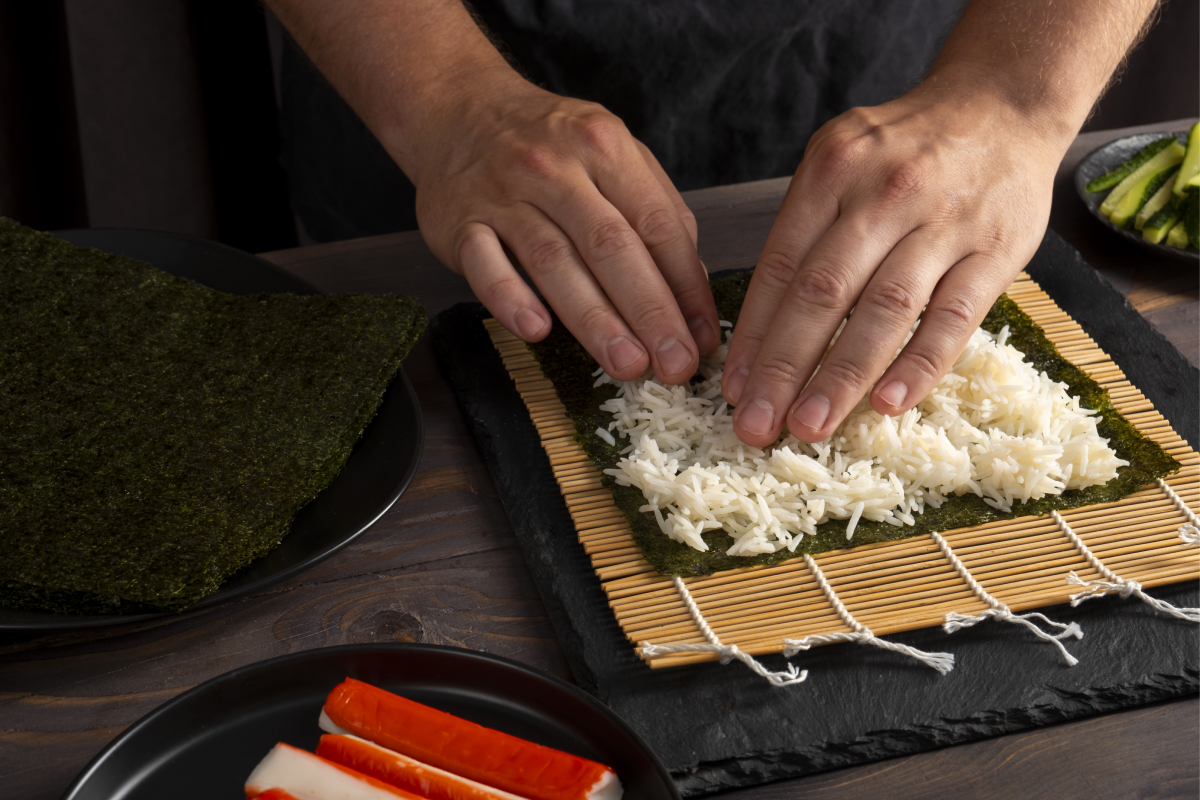Summary of the Article
Introduction to Boston Roll
Sushi, a gem of Japanese culinary art, found its way across the Pacific and nestled into the heart of American cuisine with an elegant twist. The journey from traditional Nigiri and Maki to the creation of Americanized sushi rolls has been nothing short of a gastronomic revolution. Among these, the Boston roll stands out as a testament to this blend of cultures, catering to the American palate while retaining the essence of sushi’s delicate artistry.
What is a Boston Roll?
Imagine a culinary creation that captures the essence of the sea and the freshness of a garden in a single bite. That’s the Boston roll for you. A delightful variation of the California roll, this sushi swaps out imitation crab for poached shrimp, elevating the flavor profile to new heights. Wrapped uramaki-style, with rice on the outside and nori on the inside, it features a tantalizing trio of shrimp, cucumber, and avocado. The final touch, a sprinkle of tobiko, adds a crunchy texture and a burst of color, making each roll a feast for both the eyes and the palate.
In the heart of every Boston roll lies the secret to its widespread appeal—simplicity blended with sophistication. As we peel back the layers, we find a dish that’s as much about the quality of its ingredients as it is about the technique. So, buckle up, sushi enthusiasts! We’re on a journey to uncover the magic behind the Boston roll, a dish that’s made a splash in the sushi scene across the United States.
For those intrigued by the use of shrimp in sushi, exploring “Garlic Shrimp: A Culinary Delight Everyone Should Try” can provide additional insights into the versatility and appeal of shrimp in culinary creations.
Ingredients and Preparation
Embarking on the sushi-making journey begins with gathering the freshest ingredients and understanding the preparation process. The Boston roll, with its simple yet elegant composition, is a great starting point for sushi enthusiasts and culinary adventurers alike. Let’s dive into the core components and the step-by-step guide to rolling your perfect sushi.
Ingredients of Boston Roll

Rice
The foundation of any sushi roll is the rice. For the Boston roll, sushi rice, known for its sticky texture and ability to absorb flavors, is paramount. Preparing it requires a delicate balance of rinsing, soaking, and seasoning with a blend of unseasoned rice vinegar, sugar, and salt, creating the perfect sticky base for your roll.
Nori (Seaweed Sheets)
Nori, the edible seaweed sheet, acts as a sturdy wrapper that holds the sushi roll together. Its unique taste and texture contribute significantly to the overall sushi experience.
Fillings
- Poached Shrimp: The star of the Boston roll. Poaching shrimp to just the right tenderness adds a succulent layer to the roll. Opting for sustainably sourced shrimp not only elevates the taste but also supports environmental stewardship.
- Cucumber: Adds a refreshing crunch. Julienne the cucumber for a texture that complements the softness of the avocado and the tenderness of the shrimp.
- Avocado: Sliced avocado brings creaminess and a rich flavor profile, balancing the crispness of the cucumber and the delicate taste of shrimp.
- Tobiko (Fish Roe): This not only adds a pop of color but also introduces a briny crunch that contrasts beautifully with the other textures in the roll. For those seeking alternatives, seaweed caviar or even a sprinkle of furikake can serve as excellent substitutes.
Step-by-Step Preparation Guide
- Preparing the Sushi Rice: Start by thoroughly rinsing the sushi rice until the water runs clear. Soak it for about 30 minutes, then cook it with a piece of kombu for added flavor. Once cooked, season with a vinegar mixture and spread it on a tray to cool down to room temperature.
- Assembling the Ingredients: Lay a sheet of nori on a bamboo mat, spread the cooled rice evenly, leaving a small margin at the top. Sprinkle tobiko across the rice for an extra layer of flavor and texture.
- Rolling the Sushi: Place the poached shrimp, cucumber, and avocado slices along the bottom edge of the nori. Using the bamboo mat, roll the nori tightly around the fillings, applying gentle pressure to ensure the roll is compact.
- Serving: Slice the roll into bite-sized pieces and serve with soy sauce, wasabi, and pickled ginger on the side for a complete sushi experience.
Crafting the perfect Boston roll is an art that marries the simplicity of its ingredients with the precision of its assembly. Whether you’re a seasoned sushi maker or a first-time roller, the joy of creating something so elegantly delicious is unmatched. With these steps and tips, you’re well on your way to making restaurant-quality Boston rolls right in your kitchen.
Variations and Substitutes
The beauty of sushi lies in its versatility, and the Boston roll is no exception. Whether you’re looking to spice things up a bit or cater to specific dietary needs, there are plenty of ways to tweak the classic recipe. Let’s explore some of the popular variations and substitutes that can keep your sushi nights exciting and inclusive.
Variations of Boston Roll
Creativity knows no bounds when it comes to customizing your Boston roll. Some sushi chefs like to add a drizzle of spicy mayo or a thin layer of cream cheese for an extra layer of flavor. For those who enjoy a bit of heat, incorporating thinly sliced jalapeños or a sprinkle of chili flakes can turn up the temperature on this classic roll.
Another popular variation involves playing with the toppings. Instead of tobiko, some opt for a layer of thinly sliced avocado or a sprinkle of tempura crumbs for added texture and taste. These simple twists not only bring a new dimension to the traditional Boston roll but also allow you to personalize your sushi experience.
Substitutes for Ingredients
- For Poached Shrimp: Not a fan of shrimp or dealing with allergies? Cooked crab meat, smoked salmon, or even tofu can serve as excellent substitutes, ensuring everyone can enjoy a version of this delightful roll.
- For Tobiko: For those who prefer a vegetarian option or simply can’t find tobiko, chopped nori, sesame seeds, or even crushed seaweed snacks can provide a similar crunch and visual appeal.
- For Avocado and Cucumber: While these ingredients are central to the Boston roll’s texture, feel free to experiment with other fillings such as bell peppers for crunch or mango for a sweet contrast.
The key to a great Boston roll lies in the balance of textures and flavors. By embracing variations and substitutes, you not only cater to a wider audience but also infuse your sushi with personal touches that reflect your culinary preferences and creativity. Don’t be afraid to experiment; the perfect roll is the one that best suits your taste buds.
Nutritional Information
Conclsion
In conclusion, the journey through the world of the Boston roll reveals not just the culinary delight it offers but also the artistry and consideration behind its preparation. From choosing the right ingredients to understanding the nutritional benefits and navigating through variations and substitutes, each step reflects a balance of tradition and innovation. Whether you’re rolling your first sushi at home or seeking to diversify your diet with healthy, flavorful options, the Boston roll stands as a testament to the versatility and enduring appeal of sushi in American cuisine. Embrace the adventure of making and enjoying Boston rolls, and let this guide inspire you to explore the rich tapestry of flavors and textures that sushi has to offer.
For enthusiasts keen on comparing the Boston roll with another popular variant, the article “Boston Roll vs. California Roll: Showdown” provides a detailed comparison that sushi lovers will find both informative and engaging.


